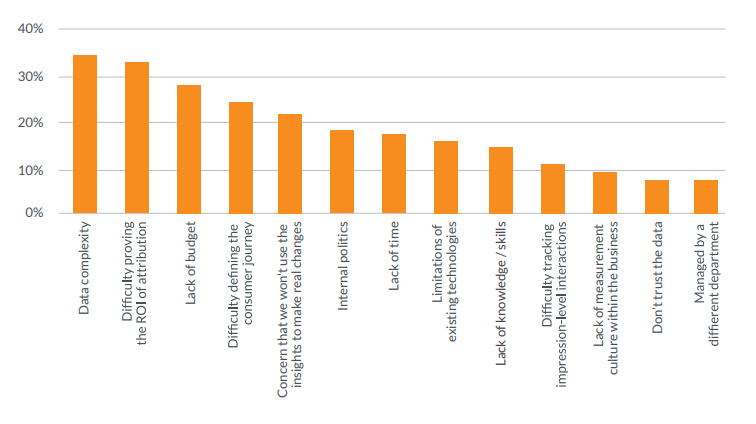Every time a customer interacts with a brand, whether it’s making an in-store purchase, clicking on an ad, or putting items into shopping carts, they are leaving vital clues about their needs, interests, and even their dislikes. However, all this data coming from so many different corners can be completely overwhelming to advertisers and marketers trying to connect the dots to get a clear picture of their audiences, both as a whole and as individuals.
And there’s probably even more data out there than most of us even realize. According to Forbes, all our clicks, taps, likes, and even purchases are creating 2.5 quintillion bytes of new data every single day. And while that data comes with unprecedented potential for a deeper understanding of customers, the sheer volume of data being produced creates challenges around linking all those little insights into a complete big picture.
Content produced in collaboration with Fospha.
“Data complexity” is one of the biggest challenges for marketers right now
According to our recent study with Fospha, “The State of Marketing, Measurement, Attribution, and Data Management,” which surveyed 370 marketing professionals, a third of respondents cited “data complexity” as one their biggest challenges right now. Specifically, it presents an obstacle to being able to use marketing intelligence technology more effectively.
What are the biggest obstacles to more effective usage of marketing intelligence technology at your organization? (Select up to three.)
Part of the reason we’re finding it so difficult to make heads or tails of the vast amount of data we are receiving is the fact that businesses haven’t been able to acquire the tools and the talent necessary for accurate analysis of their data, which is the only path to actionable insights.
According to Deloitte’s 2018 CMO Survey, many companies are looking to adopt solutions for their data problems in the near future. The survey found that marketing analytics spend is set to increase 200% over the next three years. But all that spend may not completely solve the problem, according to the survey:
“While marketing analytics is on the rise, a lack of trained professionals as well as tools/ processes to measure the impact of marketing analytics are the biggest obstacles to marketing leaders using marketing analytics within companies.”
Our survey found that even as companies spend more to adopt new technology, they still struggle to find the right technology. In fact, over 30% of our respondents listed “difficulty proving ROI” as one of their main challenges.
Businesses use around seven different technologies to get insights from their data
Just as the abundance of data comes with the blessing of opportunity but the burden of untenable quantity, the vast array of technology available for creating insights out of data has becoming equally overwhelming.
In this data-driven age, brands are finding it difficult to choose among the multitude of attribution tools available to them. So much so that some brands seem to completely freeze when presented with the paradox of choice. And with good reason: we’ve very quickly blown past the “martech 5000.” As of 2019, that number has skyrocketed to more than 7,040.
And as new tools flood the market by the thousands, many brands seem to believe that more is better when it comes to adopting data analysis tools. Our survey found that, on average, businesses were using around seven different technologies to extract insights from their data.
But only 33% of them feel their current measurement solutions perform accurate attribution of marketing campaigns
Yet adopting all those tools doesn’t come with any assurances that they will create a complete picture of customer behaviors that will be helpful to marketers in planning future strategy. Actually, the opposite seems to be true — just 33% of survey respondents believe their current measurement solutions perform accurate attribution of all marketing campaigns.
What’s an alternative, then? Using multiple tools to extract insights from data sometimes means contradictory outcomes, which can make it impossible to form a unified, company-wide data strategy.
Adopting an independent data analysis platform could have a huge, immediate impact on businesses looking for a better, more unified approach to gaining insights from their data. When used properly, an independent data analytics platform will provide brands with clarity, transparency, and a better performance analysis. Businesses can then make the most of their spend on analytics tools by investing in attribution software and marketing automation, streamlining strategies based on understanding the data and ultimately making informed, data-based decisions.
To find more insights about these topics, you might like to check out the full report here.
The post “Data complexity” is one of the biggest challenges for marketers right now, and current tools aren’t helping enough appeared first on ClickZ.
